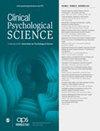The Longitudinal Association Between Posttraumatic Stress Disorder, Emotion Dysregulation, and Postmigration Stressors Among Refugees
IF 4.8
2区 医学
Q1 PSYCHIATRY
引用次数: 1
Abstract
Although emotion dysregulation has been robustly associated with posttraumatic stress disorder (PTSD), there is relatively little understanding of this process in refugees. Specifically, longitudinal methodology has not been used to examine the relationship between emotion dysregulation and PTSD among refugees. In this study, we investigated the temporal relationship between emotion dysregulation, postmigration stressors, and PTSD clusters (reexperiencing, avoidance, negative alterations in mood and cognition [NAMC], and hyperarousal) from the fifth edition of the Diagnostic and Statistical Manual of Mental Disorders among a community sample of refugees ( N = 1,081) over a 2-year period. Random intercept cross-lagged panel analysis found that emotion dysregulation was antecedent to within-persons increases in reexperiencing and NAMC symptoms over time and bidirectionally associated with hyperarousal and postmigration stressors. In addition, postmigration stressors were antecedent to within-persons increases in reexperiencing, avoidance, and NAMC and bidirectionally associated with hyperarousal symptoms. Findings provide novel evidence in support of postmigration stressors and emotion dysregulation as mechanisms maintaining PTSD and highlight the potential utility of tailoring interventions to address these factors.难民创伤后应激障碍、情绪失调和移民后应激源的纵向关联
尽管情绪失调与创伤后应激障碍(PTSD)密切相关,但对难民这一过程的了解相对较少。具体来说,还没有使用纵向方法来检查难民情绪失调和创伤后应激障碍之间的关系。在这项研究中,我们调查了情绪失调、移民后压力源和创伤后应激障碍集群(再体验、回避、情绪和认知的负面改变[NAMC]和过度觉醒)之间的时间关系,这些关系来自于《精神障碍诊断与统计手册》第五版,在一个社区难民样本中(N = 1081)进行了为期两年的研究。随机截距交叉滞后面板分析发现,随着时间的推移,情绪失调先于人体内再体验和NAMC症状的增加,并且与过度觉醒和迁移后压力源双向相关。此外,迁移后应激源先于人体内再体验、回避和NAMC的增加,并与高唤醒症状双向相关。研究结果为支持移民后应激源和情绪失调作为维持PTSD的机制提供了新的证据,并强调了针对这些因素的定制干预的潜在效用。
本文章由计算机程序翻译,如有差异,请以英文原文为准。
求助全文
约1分钟内获得全文
求助全文
来源期刊

Clinical Psychological Science
Psychology-Clinical Psychology
CiteScore
9.70
自引率
2.10%
发文量
35
期刊介绍:
The Association for Psychological Science’s journal, Clinical Psychological Science, emerges from this confluence to provide readers with the best, most innovative research in clinical psychological science, giving researchers of all stripes a home for their work and a place in which to communicate with a broad audience of both clinical and other scientists.
 求助内容:
求助内容: 应助结果提醒方式:
应助结果提醒方式:


